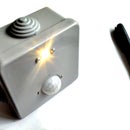Introduction: Baobab Germination - the Angle Grinder Method
Baobab (Adansonia sp.) seeds need a bit of help to germinate on-demand, at home. They have an incredibly hard seed skin that needs to be penetrated mechanically to allow the water in and start the magic. We also show how to help the young plant out of the seed shell before the trapped seedling starts to rot inside.
We find it too dangerous to life and limb to try and chip away at the stone-hard seed with a sharp knife. It's time for power tools!
Local rednecks Katarina, Andrej and Matjaz make use here of an angle grinder, pliers and a cup of water, to scarify seeds and achieve near 100% germination (20 out of 20 so far).
Step 1: Scarification, Day 0.
Grind away at the fat side of the seed (away from the indented side), as shown in the photos.
Note that this will tend to locally overheat the seed. We dunk it briefly into the cup of cold water every couple of seconds during the grind. You are done when you just about start to see the white interior of the seed.
Step 2: First Soak, Day 1&2.
Give the seeds an overnight soak in tepid water. This will start to soften the hard seed shell from inside out. From a hardness similar to that of a walnut shell, it will gradually, over the hours, soften until the consistency of rotten wood.
After the soak, check on the seeds to see if you can already use your thumb fingernails to remove some of the seed coat, starting where the hole was ground through and working outward, partially exposing the creamy-white embryo. If you can do it gently, remove about a half of the seed shell at this stage. Don't remove all of it at once, you will probably break the embryo if you try.
In any case, do not leave the seed in water for more than 12 hours at one time. Give it a good rest with plenty of air to prevent any rotting. We wrap it in just slightly moist paper towel and protect from drying out between two plastic cups.
Whether still in the shell or half naked at this point, give it another several hour water soak just like the day before.
After this second soak, the seed coat will definitely become soft enough to work away. Be gentle, again, don't force away all of the coat in one go, 1/2 in one day, 1/2 the next day when it becomes far easier.
The embryos are almost animal-like, the forming root is well visible and they appear full of life.
Step 3: Unfolding Life, Day 3&4.
Naked embryos get one or two more overnight drinking campaigns, interleaved by the previously described moist towel aerobic holidays.
If you can do so gently, use tweezers to remove some of the loose "packing material" from between the folds of the leaves (see second photo) because they tend to trap liquid water and are a potential rot risk. Don't be too strong though - breaking the little plant in half is far more damaging. :)
At this stage, the little beasts are in an excellent shape for potting...
Step 4: Mother Nature Takes Over Here, Day 5-6.
For each plant, we poke 3 drainage holes (with a hot cheap old soldering iron) through the bottom of a 300-400ml (10oz+) disposable plastic cup and fill it with a 50:50 perlite + peat nursery mix. It ís so airy and well draining that even luxurious watering does not induce the infamous root rot in Baobabs.
Baby seedlings are placed root-tip-down in the mix and covered with an extra few mm (1/4") of the same mix.
It only takes hours to a couple of days in a warm bright place to see the plant going green and pushing out of the mix.
Step 5: Still Lookin' Good, Day 21 & Day 365000.
Our Baobab is now 21 AG (=days since Angle Grinder).
Note the tool burns from the birth. The seedling is firm and healthy, root tips reaching cup bottom and sides. First very dilute liquid fertilizer lunch was one week ago, followed within days by a rapid growth of the first set of true leaves.
A few ceramic pots (and centuries) later we hope to cast shadow over an elephant. The tree in the photo was born in an earlier Instructable and grown under 6500K hydrogen fusion light.
Step 6: Preppin' for Winter.
Fall same year (November 17th 2016), they feel lack of light and warmth, and slowly defoliate (central Slovenia is approx. USDA zone 7).
We took them out of the pots, to find some "athlete's foot" fungal problems at the bottom. Partial amputation until firm healthy tissue, followed by sulfur dusting of the wound.
At this stage, we go the dry season. They will be hanging in mid air from a string, indoors, next to a window.




